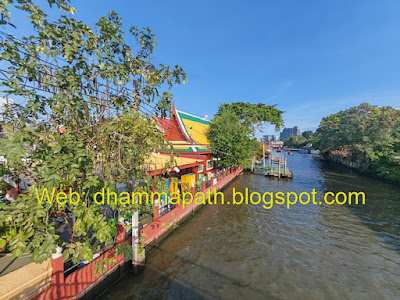Photo taken at front of sala building Ratchasangwaraphimon. It is a Thai style building which houses a replica of Phra Buddha Chinnaraj statue and also venerated the wax statue of Phra Rajasangwaraphimonthon ~ Luang Pu Toh.
LP Toh Phrarajasangwaraphimonthon (Toh Inthasuwanno) Wat PraduChimphli, he is a senior monk who is widely respected by people. Luang Pu Toh was born on March 27 BE2430 and when 20 years old, he entered the ordination ceremony on July 16 BE2450 at Phatthasima, Wat PraduChimplee. Luang Pu Toh studied and practiced Gandadhura and Vipassanadhura and passed the examination to become a third-level Dhamma scholar. Later when Phra Athikan Kham passed away, the Sangha appointed Luang Pu Toh to hold the position of abbot of Wat PraduChimplee to succeed him on July 10 BE2456.
Luang Pu Toh went on a pilgrimage to every region in Thailand, including the North, Northeast, and South. He went to study the Pariyatthamma and study Buddhagama. By entrusting himself as a disciple of many important teachers such as Luang Pho Rung of Wat Tha Krabue, Luang Pho Nong of Wat Khlong Madan, and he studied Vipassana meditation with Luang Pho Chum of Wat Ratchasitharam. As for his famous sahadhamikas, they include Luang Pho Parn of Wat BangNomKho, Luang Pho Sod of Wat PakNam, Luang Pho Chaeng of Wat Bang Phang, Luang Pho Klai of Wat Hong Rattanaram. And after that, he went on a pilgrimage in the North and South again before returning to Wat PraduChimplee. He had his last illness in February BE2524 and only 7 days before his death, he could not get out of bed at all. Until on March 5 BE2524 at 9:55 am, he passed away peacefully. Aged 93 years, 73 years of phansa.
The main and very beautiful with replica of Phra Buddha Chinnaraj at center altar.The sacred wax statue of Luang Pu Toh. Photo taken with the wax statue.
The sacred standing statue of mercy Guan Yin inside the sala building.
The antique ceramic items safe kept in cabinet and big Holy Water Bowl (with amulets outer). This sacred Batnammon bowl used by LP Toh.
The Pavilion of King Taksin the Great.
The amulet counter at Wat PraduChimplee.
The wiharn building of Wat PraduChimplee.
The sacred White Chedi and the Wiharn.
The sacred Standing Phra Buddha image.
Photo taken with Phra Buddha's statues and footprint.
The sacred Reclining Buddha statue with new wallpaper decoration. See back my old posted to see the different.
The walkway along to the school.
.
See more amulets from LP Toh & Wat PraduChimPlee at:
http://thaiamulets-dhammapath.blogspot.com/search/label/Wat%20Praduchimplee
.
See more Thai amulets at:





















































